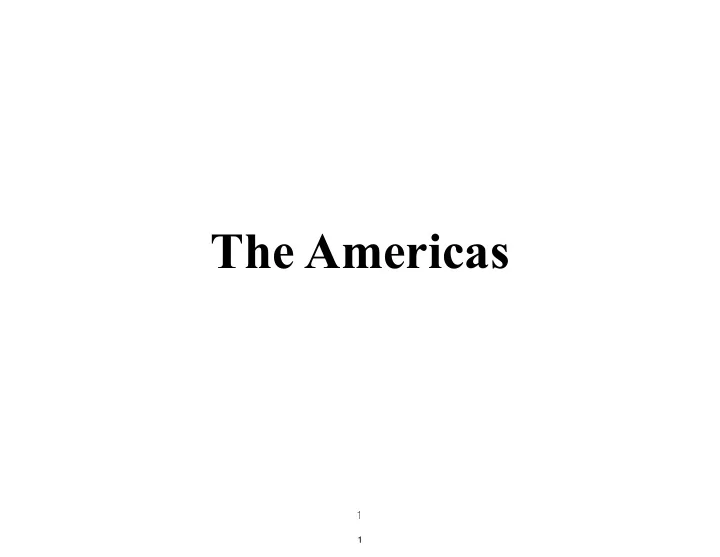

The Americas � 1 1
Major Questions before Ancient Genomes 1. When did humans arrive in the Americas? 2. By what route did they get come? � 2 2
Beringia Wikipedia � 3 3
Ancient PaleoSiberians and Ancient Beringians Trail Creek Cave Figure 1A from Sikora et al. - 2018 - The population z .pdf � 4 4
Two Routes to the South a Anzick Extent of glaciation 16,000 cal BP 14,000 cal BP 13,000 cal BP Figure 1a from Rasmussen et al. - 2014 - The genome of a Late Pleistocene human from a Clov .pdf � 5 5
Big Bar Lake, Canada, 5,600 Years Ago Google Maps � 6 6
Divergence between Northern and Southern � 7 7
Northern Native Americans Na-Dené Language Distribution Algonquinian Language Distribution Wikipedia � 8 8
Earliest American Genome Anzick 12.6 kya Clovis13.0 kya Google Maps � 9 9
The Clovis Culture Wikipedia � 10 10
Earliest Native American Genomes Kennewick 9.0 kya Anzick 12.6 kya Paisley 12.8 kya Spirit Cave 10.7 kya Clovis 13.0 kya Google Maps � 11 11
The Explosion Google Earth � 12 12
Two Studies of Ancient American Genomes Published on the same day (November 8): • Reich’s group, in Cell : “Reconstructing the Deep Population History of Central and South America”, Posth et al. - 2018 - Reconstructing the Deep Population History of Cent.pdf • Willerslev’s group, in Science : “Early human dispersals within the Americas”, Moreno-Mayar et al. - 2018 - Early human dispersals within the Americas.pdf � 13 13
Anzick-Related Ancestry in South America Posth et al. - 2018 - Reconstructing the Deep Population History of Cent (Fig 1A) .pdf � 14 14
Anzick-Related Ancestry in South America Moreno-Mayar et al. - 2018 - Early human dispersals within the Americas (fig 1A) .pdf � 15 15
Subsequent Dilution and Admixture Dilution of Anzick-related ancestry in South America • Source unknown • Timing unknown Some later admixture can be identified • Channel-Islands-related • Mixe-related � 16 16
Before 4,200 Years Ago Posth et al. - 2018 - Reconstructing the Deep Population History of Cent (Fig 1A) .pdf � 17 17
After 5,000 Years Ago Moreno-Mayar et al. - 2018 - Early human dispersals within the Americas (fig 1A) .pdf � 18 18
After 5,000 Years Ago Saqqaq Based on Figure 1A from Sikora et al. - 2018 - The population z .pdf � 19 19
Na-Dené (Athabascan) Languages Based on Flegontov et al. - 2017 - Paleo-Eskimo genetic legacy (Fig 6a) .pdf � 20 20
Northern Native Americans Na-Dené Language Distribution Algonquinian Language Distribution Wikipedia � 21 21
Possible Neo-Eskimo Origin 3,100-2,500 BP Proto Paleo- Eskimo Neo- Eskimo Northern Native American Based on Flegontov et al. - 2017 - Paleo-Eskimo genetic legacy (Fig 6b) .pdf � 22 22
Old Bering Sea Culture after 2,200 BP Neo- Old Bering Eskimo Sea Culture Proto-Aleut Based on Flegontov et al. - 2017 - Paleo-Eskimo genetic legacy (Fig 6b) .pdf � 23 23
Thule Culture about 1,150 Years Ago Based on Flegontov et al. - 2017 - Paleo-Eskimo genetic legacy (Fig 6b) .pdf � 24 24
Figure 2. Principal component analysis (PCA) on the HumanOrigins datasets prior to any 1045 outlier removal. A plot of two principal components (PC1 vs. PC2) is presented. Calibrated 1046 radiocarbon dates in calBP are shown for ancient samples (large circles). For individuals, 1047 95% confidence intervals are shown, and for populations, minimal and maximal dates 1048 among all confidence intervals of that population are shown. A similar plot for the Illumina 1049 dataset is displayed in Extended Data Fig. 3, and plots for the datasets used for 1050 qpWave/qpAdm analyses are shown in Supplementary Information section 4. In those 1051 datasets, First American, Chukotko-Kamchatkan-speaking and Eskimo-Aleut-speaking 1052 individuals having >1% European, African, or Southeast Asian ancestry according to 1053 Principal Components Analysis ADMIXTURE were removed. 1054 1055 Southern Native Americans Northern Native Americans Europeans Ancient N. Athabaskans N. Athabaskans Ancient Aleuts Eskimo- West Ancient Neo-Eskimos Aleuts Siberians Chukotko-Kamchatkans Paleo-Eskimos East Siberians SE Asians 1056 1057 Flegontov et al. - 2017 - Paleo-Eskimo genetic legacy (Fig 2) .pdf 1058 25 � 25
Simplified Partial Demography of the Americas Neo-Eskimo Proto Paleo- Paleo- Eskimo Eskimo Athabascan NNA (Na-Dené) Algonquin AB Kennewick SW Ontario Early SNA Anzick East SAm Later Asia Pal SAm Sib ??? ANE South Early America CAm Mixe Unknown Population A � 26 26
Paleoamericans Hypothesis • Archaeological and anthropological research, not genomics • Distinctive skull shape of some ancient and current Native Americans • Similar to skull shape of some indigenous Asian populations • Mainly from a single research group � 27 27
The “Population Y” Hypothesis Ami Mamanwa Cabecar Papuans Onge Xavante Suruí 0.003 Karitiana Tongan Australians − 0.001 Skoglund et al. - 2015 - Genetic evidence for two founding populations of t (Fig 1d) .pdf � 28 28
Current Status Paleoamerican hypothesis • No correlation with genomics • Any real difference has environmental causes Population Y hypothesis • Both labs confirmed faint signal • Willerslev doubled down • Reich raised possibility of a false positive � 29 29
Recommend
More recommend